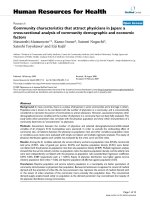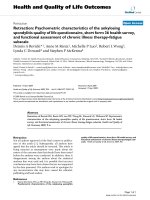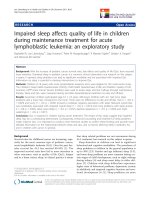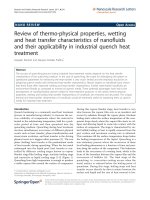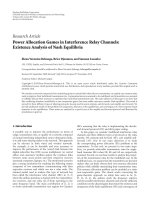Research characteristics of immunologic markers in pediatric acute lymphoblastic leukemia with genetic mutation in national institute of hematology and blood transfusion from 2016 to 2018
Bạn đang xem bản rút gọn của tài liệu. Xem và tải ngay bản đầy đủ của tài liệu tại đây (645.78 KB, 7 trang )
Research characteristics Bệnh
of immunologic
viện Trung markers...
ương Huế
RESEARCH CHARACTERISTICS OF IMMUNOLOGIC MARKERS
IN PEDIATRIC ACUTE LYMPHOBLASTIC LEUKEMIA WITH GENETIC
MUTATION IN NATIONAL INSTITUTE OF HEMATOLOGY AND
BLOOD TRANSFUSION FROM 2016 TO 2018
Hoang Thi Hong1, Mai Lan1, Nguyen Quang Tung1,
Nguyen Trieu Van1, Bach Quoc Khanh1
ABSTRACT
diagnosis, treatment and prognosis in pediatric ALL.
Objective: Research characteristic of cluster of differentiation in pediatric ALL with genetic mutations in
National institute of Hematology and Blood transfusion from 2016-2018.
Methods: Cross-sectional descriptive on 189 pediatric patients aged 1-15 years old with newly
diagnosis ALL.
Results. Frequency of fusion genes was 26.9% (fusion gene TEL-AML1 13.2%, BCR-ABL 8.5%, E2APBX1 2.6%, MLL-AF4 2.6%). B - ALL was prevalent with 82.0%; T - ALL accounted for 16.4%. 97,8% of
the patients with genetic mutation were in group of B-ALL. CD45 showed strong positive expression in
of CD34 patients was highest in the BCR-ABL1 fusion gene group. The E2A-PBX1 gene mutation group
was negative for CD34. The presence of CD19, CD79a markers was high in pediatric patients. CD10 (+)
was low in the MLL-AF4 group. The incidence of CD20 was low in the groups. The incidence of myeloid CD
was highest in BCR-ABL1 (37.5% positive for CD33), without the presence of myeloid CD in the pediatric
patients with the E2A- PBX1 and MLL-AF4 fusion gene.
I. INTRODUCTION
Acute lymphoblastic leukemia (ALL) accounts
for about 25% of childhood cancers and about
1% of adult cancers. About 60-70% of ALL
have genetic changes. The presence of genetic
alterations and characteristics of immunologic
markers are important in prognosis, evaluating
the therapeutic response for ALL [1], [2], [ 3].
In Vietnam, the relationship between genetic
variation and immunological traits has not been
studied extensively. So we conducted this research
with the aim:
- Research characteristics of immunologic
markersin pediatric all with genetic mutation
in national institute of hematology and blood
transfusion from 2016 to 2018.
II. SUBJECTS AND METHODS
2.1. Subjects of Study
189 pediatric patients who were diagnosed
with acute lymphoblastic leukemia newly
according to the WHO 2008 standard, treated
1. National Institute of Hematology - Received: 8/8/2018; Revised: 16/8/2018
and Blood transfusion
- Accepted: 27/8/2018
- Corresponding author: Hoang Thi Hong
- Email: Tel: 0983885350
12
Journal of Clinical Medicine - No. 51/2018
Hue Central Hospital
in Pediatric Department, National Institute
of Hematology and Blood Transfusion from
01/8/2016 to 30/4/2018.
2.2. Research Methods
- Study Design: Cross-sectional descriptive
study
- Criteria for selecting patients:
• Patients diagnosed with acute lymphoblastic
leukemia, aged 1-15.
• No previous chemotherapy or corticosteroids.
• Be fully tested
• The family agrees to participate in the study.
- Steps of Study:
• Do bone marrow aspirate.
• PCR assay for mutation of TEL / AML1, E2A /
PBX1, BCR / ABL, MLL / AF4 fusion gene.
• Immunization tests by flow cytometry with
panel of the NIHBT.
• Analyze characterization of immunologic
markers with genetic variations.
III. RESULTS
3.1. Characteristics of age and gender
Figure 3.1. Distribution of pediatric patients by sex and age group (n=189)
Male patients in the study group were higher than the female patients. The ratio of male / female was
1.45 / 1. Age group 1-5 represented the highest proportion with 54.5%.
3.2. Distribution of pediatric patients by immunological classification
Immunological classification
n
%
B – ALL
155
82.0
T – ALL
31
16.4
Mixed B/T – ALL
1
0.5
Mixed acute lineage leukemia
2
1.1
189
100
Total
Table 3.1. Distribution of pediatric patients by immunological classification (n=189)
B - ALL was prevalent with 82.0%. T - ALL accounted for 16.4%. The study also had low level (1.6%)
mixed acute lineage leukemia
Journal of Clinical Medicine - No. 51/2018
13
Research characteristics Bệnh
of immunologic
viện Trung markers...
ương Huế
3.3. Rate of genetic variations in the study
Table 3.2. Rate of genetic variations in the study (n=189)
Genetic variations
n
%
138
73.1
TEL-AML1
25
13.2
BCR-ABL1
16
8.5
E2A-PBX1
5
2.6
MLL-AF4
5
2.6
189
100
No gene mutations detected
Fusion genes detected
(n=46, 26.9%)
Tổng
The detection rate of fusion genes which research in the study was low (26.9%). The emergence of
the TEL-AML1 fusion gene accounted for the highest rate of 13.2%. 8.5% of pediatric patients had the
BCR-ABL1 fusion gene. Patients with E2A-PBX1 and MLL-AF4 fusion genes accounted for the same
proportion (2.6%).
3.4. Classification of immunity by fusion gene groups
Table 3.3. Classification of immunity by fusion gene groups (n=46)
Immune phenotype
B-ALL
T-ALL
Total
Fusion gene
TEL-AML1
25 (100%)
0 (0%)
25 (100%)
BCR-ABL1
15 (93,8%)
1 (6,2%)
16 (100%)
E2A-PBX1
5 (100%)
0 (0%)
5 (100%)
MLL-AF4
5 (100%)
0 (0%)
5 (100%)
Total
45 (97,8%)
1 (2,2%)
46 (100%)
97.8% of patients with four fusion genes belonged to the B-ALL group. Only one pediatric patient
(2.2%) had BCR-ABL1 fusion gene in the T-ALL group.
3.5. Characteristic of CD45 expression in fusion gene groups
Figure 3.2. Characteristic of CD45 expression in fusion gene groups (n=189)
Most pediatric patients had a strong CD45 level of expression. 100% of patients with BCR-ABL1 and
E2A-PBX1 fusion gene had positive with CD45 strongly. The incidence of strong CD45-positive patients
in the non-fusion gene group was 74.6%, TEL-AML1 fusion gene group was 72% and MLL-AF4 group
was 80%.
14
Journal of Clinical Medicine - No. 51/2018
Hue Central Hospital
3.6. Characteristic of CD 34 and HLA-DR expression in fusion gene groups
Table 3.4. Characteristic of CD34 and HLA-DR expression in fusion gene groups (n=189)
CD
HLA-DR
CD34
Fusion genes
Negative
Positive
Negative
Positive
No fusion genes detected
31.2%
68.8%
38.4%
61.6%
TEL-AML1
4.0%
96.0%
24%
76%
BCR-ABL1
18.8%
81.2%
6.2%
93.8%
E2A-PBX1
0%
100%
100%
0%
MLL-AF4
0%
100%
20%
80%
p<0,05
p<0,01
- The rate of HLA-DR expression was high in fusion gene goups.
- There was high incedence of CD 34 in groups of BCR-ABL1; MLL-AF4 and TEL-AML1 fusion gene.
All patients with E2A-PBX1 fusion gene were negative with CD34.
3.7. Characteristic features of B- cell phenotype in fusion gene groups
Table 3.5. Characteristic features of B- cell phenotype in fusion gene groups (n=46)
TEL-AML1
BCR-ABL1
E2A-PBX1
MLL-AF4
CD10 (+)
100%
93.8%
100%
20%
CD19 (+)
100%
87.5%
100%
100%
CD20 (+)
12.0%
25.0%
0%
20%
CD79a (+)
100%
93,8%
100%
100%
CD19 and CD79a had been shown to appear at high rates in fusion gene groups. Few patients with MLLAF4 had positive with CD10 (20%). The incidence of CD20 positive patients was low in fusion gene group
and did not appear in the E2A-PBX1 fusion gene group.
3.8. Characteristics of abnormalities immune marker in fusion gene groups
Table 3.6. Characteristics of abnormalities immune marker in fusion gene groups
TEL-AML1
BCR-ABL1
E2A-PBX1
MLL-AF4
CD13 (+)
4.0%
0%
0%
0%
CD33 (+)
4.0%
37.5%
0%
0%
CD56 (+)
4.0%
6.2%
0%
0%
The rate of patients who had abnormalities immune marker was the highest in the BCR-ABL1 fusion
gene groups, with CD33 (+) in 37.5% and CD56 (+) in 6.2%. Myeloid imprints did not appear in pediatric
patients with E2A-PBX1 and MLL-AF4 fusion gene.
IV. DISCUSSION
4.1. Characteristics of age and gender
Our research is similar to that of Mai Lan (2015),
Tran Quynh Mai (2016), the ratio of male was
higher than female, the age group 1-5 represented
the highest proportion in pediatric ALL patients of
NIHBT.
4.2. Classification of pediatric patients
according to immune markers.
The proportion of B-cell ALL patients is
dominant with 82%, meanwhile the percentage of
T-cell ALL patients is 16,4% and the rest is the level
Journal of Clinical Medicine - No. 51/2018
15
Research characteristics Bệnh
of immunologic
viện Trung markers...
ương Huế
of hybrids (Table 3.1). This result is well suited to (4,3%). The mixed acute lineage leukemia is rare in
various domestic and international researches. The Vietnam and the world.
proportion of ALL fluctuates around 85%, T-cell
4.3. Incidence of the investigated genetic
ALL is about 15%. The study of author Hoang Chi mutations.
Cuong about classification of immunity in pediatric
In our study, 189 ALL patients were examined
lymphoblastic leukemia showed 78.7% B-cell ALL, the genetic expression and got the results that the
while 17% T-cell ALL. According to our research, genetic mutation group was 26.9%, the TEL /
the percentage of the mixed acute lineage leukemia AML1 gene was 13.2%, BCR / ABL 8.5%, E2A /
(1,6%) is lower than in the Hoang Chi Cuong study PBX1 2.6%, MLL / AF4 2.6% (Table 3.2).
Table 4.1. Comparing the rate of mutated gene detection with some domestic
and international studies.
Authors
BCR/ABL (%) TEL/AML1 (%) E2A/PBX1 (%)
MLL/AF4 (%)
Yanming Zhang5
25
5
5-7
Michelle M Le Beau
Terzah M Horton3-4
20-25
5
5
C Philip Steuber
Karen Rabin3
25
6
8
Judich Margolin
C.H.Pui
2-3
20-25
4
2
Cheryl L. Willman
2
28
6
4
P.T.D. An
3
25
5
8
T.Q.Mai (n=104)
10
14
4
2
Our study (n=189)
8.5
13.2
2.6
2.6
Consequently, our proportion of mutated gene T-cell ALL with BCR-ABL1 p190 fusion gene [8].
detection is still relatively low compared to research The research on the characteristics of several
in the world. Our research is similar to that of Tran immune markers in the group with genetic mutation
Quynh Mai, the proportion of patients with BCR- which have also recorded initially some results:
ABL1 fusion gene was higher compared with other
- In terms of the level of CD45 expression, the
studies. This may be due to the fact that many study found that the CD45-high positive rate (over
patients were transferred to the National Institute 75% of the Blast population is positive with CD45)
of Hematology and Blood Transfusion in high risk in most groups, especially in the BCR-ABL1 and
groups, so the frequency of fusion gene detection is E2A-PBX1 fusion gene group. According to the
higher than in other studies.
study of author Hoang Chi Cuong, CD45 expres4.4. Immune marker characteristics in the sion is strong positive with 68.9% B-cell ALL,
mutated gene group
statistically meaningful lower than with T-lymphoTable 3.3 illustrates that 97.8% pediatric patients cytes (95.7%). In our study, the majority of patients
which were mutated the surveyed genes is in the with genetic mutation belonged to the B-cell ALL
B-cell ALL group. Because majority of ALL is B-cell group, therefore the overall result of strong positive
as well as almost surveyed genes are featured for CD45 expression level was similar to that of the Bthe B- cell ALL. Especially, the study encountered cell ALL. In our study, it was found that CD45 had
a case of T-cell ALL with BCR-ABL1 fusion gene. a significantly higher level of positive expression in
The literature also reported several instances of the at normal risk population (TEL-AML1) than in
16
Journal of Clinical Medicine - No. 51/2018
Hue Central Hospital
the high risk group. However, due to the low number of pediatric patients, the difference was not statistically significant.
- Our results present that blast cells in the TELAML1, BCR-ABL1 and MLL-AF4 genetic complex
group are high level positive with young markers:
HLA-DR and CD34 markers. This result is similar
to the study by Ludwig WD et al. (1997) on B-cell
ALL, with a HLA-DR strong positive ratio of 100%
(57/57 patients), CD34 positive proportion is 58%
(29/50 patients). Other studies have also shown that
HLA-DR (+) in all subtypes of B-cell ALL (100%),
and CD34 positive in 70% of patients [8]. Pediatric
patient group with the E2A-PBX1 fusion gene had
a high positive rate with HLA-DR (100%) but were
negative for CD34. Several studies have also shown
that patients with E2A-PBX1 fusion gene are generally positive for CD19, CD10, CD79a, HLA-DR
but negative for CD34 [10].
- Among the examined hallmarks of B lymphocytes, the CD19, CD79a markers had a high
positive rate. CD 20 had a lower positive rate
than other B-type imprints because these mutated
gene groups were mostly in B-cell or pro B-cell
groups. CD10-positive rates were found low in
the group with the MLL-AF4 fusion gene, high
in the groups with the other mutated gene. This
is consistent with many studies. The MLL-AF4
genetic complex appears with a high proportion
in less than 6 months of age and older infants,
and several studies have also shown that most patients with MLL-AF4 fusion gene have no CD10
on there surface [9].
- Occurrence of myeloid markers in ALL may be
observed at rates ranging from 13 to 28% in some
studies. In our research, the incidence of myeloid
markers was not high, but found primarily that the
incidence of myeloid markers is highest in BCRABL1, especially CD33 was positive in 37.5% of
cases. Several studies have also found that the incidence of myeloid imprints may be as high as 30% in
cases of BCR-ABL1 [9].
V. CONCLUSION
In a study of 189 children with acute
lymphoblastic leukemia at the NIHBT, we had
some conclusions:
- B-cell ALL accounted for the majority (82%);
97.8% of patients with genetic variation were in the
B-cell ALL group.
- A rare case of BCR-ABL1 fusion gene belonged
to T-cell ALL.
- CD45 expression was high in most groups
with genetic modification.
- The rate of HLA-DR imprints was high in
genetically modified groups
- The CD34-negative count in the E2A-PBX1
group was high in the remaining groups.
- The CD19, CD79a (+) levels was high in all
the groups. CD10 (+) was low in the MLL-AF4
fusion gene. The incidence of CD20 was low in all
the groups.
- Incidence of myeloid CD was highest in BCRABL1 (37.5% positive for CD33).
REFERENCES
1.Ching-Hon Pui, William L. Carroll, Soheil
Meshinchi, and Robert J. Arceci (2011), Biology, Risk Stratification, and Therapy of Pediatric
Acute Leukemias: An Update, Journal of clinical
Oncology, Vol 29, 2011.
2. Stephen P. Hunger, Charles G. Mullighan, Redefining ALL classification: toward detecting highrisk ALL and implementing precision medicine,
Blood, 25 june 2015 , volume 125, number 26,
p 3977-3987.
3. Hoang Chi Cuong (2014), Study on immunosuppressive markers in pediatric acute lymphoblastic leukemia by flow cytometry at the National
Institute of Hematology and Blood Transfusion,
Master of Medicine thesis, Hanoi Medical University.
4. Mai Lan (2016), Research distribution of pediatric blood disease in National Institute of Hema-
Journal of Clinical Medicine - No. 51/2018
17
Research characteristics Bệnh
of immunologic
viện Trung markers...
ương Huế
tology and Blood Transfusion from 2013-2015,
Specialist doctor level II, NIHBT.
5. Tran Quynh Mai (2016), Study on clinical characteristics, laboratory and response to induction
treatment of acute lymphoblastic leukemia in children with genetic mutation at the National Institute of Hematology and Blood Transfusion, Master of Medicine thesis, Hanoi Medical University.
6. Phan Thi Duy An, (2011), Survey on characteristics of cytogenetic and molecular biology in
lymphoblastic leukemia in children in pediatric
department of BTH from March 2010 to March
2011, Master of Medicine thesis, HCM University of Medicine and Pharmacy.
7. Patrizia Comoli et al (2017), BCR-ABL–specific
T-cell therapy in Ph+ ALL patients on tyrosine-
18
kinase inhibitors, Blood, 2017, 129:582-586.
8. CH Pui, FG Behm and WM Crist (1993), Clinical and biologic relevance of immunologic
marker studies in childhood acute lymphoblastic
leukemia, blood 1993, Blood, Vol 82,1993: pp
343-362.
9. Sanam Loghavi, et al (2015), B-Acute Lymphoblastic Leukemia/Lymphoblastic Lymphoma,
Am J Clin Pathol September 2015;144:393-410.
10. Borowitz MJ, Hunger SP, Carroll AJ, Shuster
JJ, Pullen J, Steuber CP, Cleary ML. Predictability of the t(1;19)(q23;p13) from surface antigen
phenotype: implication for screening cases of
childhood acute lymphoblastic leukemia for molecular analysis: a Pediatric Oncology Group
Study. Blood. 1993;83:1086–91.
Journal of Clinical Medicine - No. 51/2018



